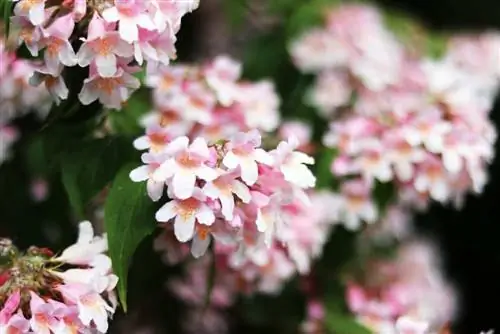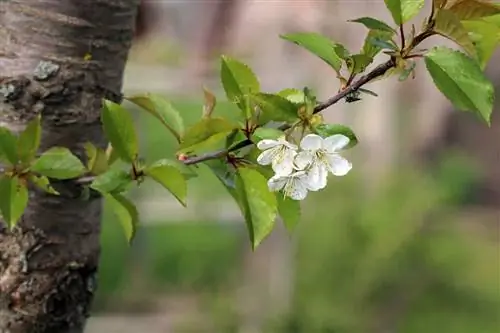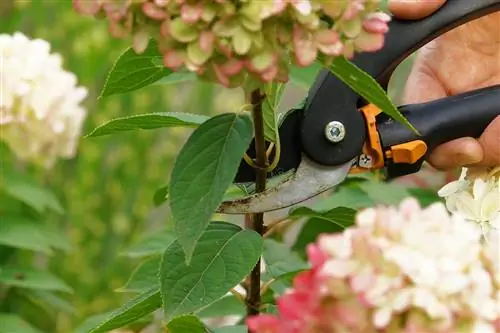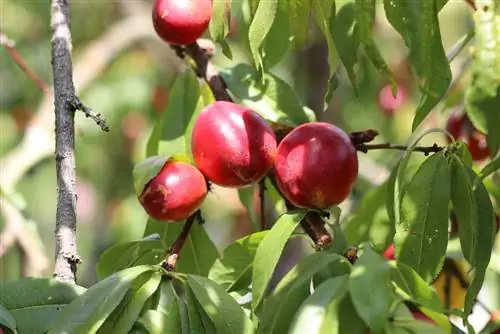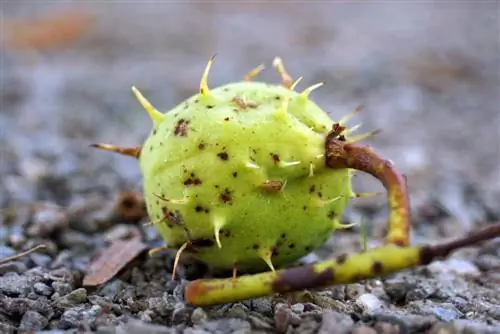- Author admin [email protected].
- Public 2023-12-17 03:39.
- Last modified 2025-06-01 06:48.
The Kolkwitzia (Kolkwitzia amabilis) is a subshrub that originally comes from China. The honeysuckle plant is becoming more and more common in German gardens and many gardening enthusiasts are asking themselves how and when the right cut needs to be done. Due to the robust nature of the pearl bush, pruning is only important in later years.
When should you cut the mother-of-pearl bush?
The right time to cut a Kolkwitzia depends on the age, location and previous care of the plant. The shrub is called “beauty bush” in English, which translates to “beauty bush” and primarily refers to the natural attractiveness of the plant. It does not require much care and, above all, no topiary, as the shrub grows very regularly and does not sprout too much. Added to this is the slow growth of just 20 to 30 centimeters per year.
As it grows, the Kolkwitzia will reach a height and width of three to four meters and will grow evenly without the need for topiary pruning. Topiary pruning could even disrupt the plant's growth and destroy the desired shape of the shrub. After that, this can only be restored over a rest period of several years, which is a long wait for every gardener.
There are three different types of pruning for the mother-of-pearl bush, which are used at different times and for different purposes. These are:
- pruning
- Blending cut
- Rejuvenation cut
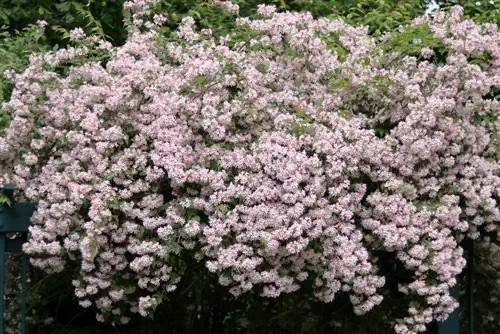
Please note: the winter-hardy nature of the shrub proves to be an advantage over other shrubs that have to overwinter outside. Nevertheless, you should avoid making any of these cuts before the onset of winter. The branches could suffer from the fresh cut and would freeze. This is particularly important for young Kolkwitzias in the first three to four years and specimens that grow in pots. In general, these should never overwinter outside. However, older specimens can survive a rejuvenation cut of the oldest branches even in autumn and then sprout more quickly in the spring. However, this should be done carefully, especially in colder regions that have to endure a harsh winter.
Pruning directly after flowering in summer
As with roses and other shrubs, it is advisable to prune Kolkwitzia every year immediately after flowering. This pruning is carried out in the summer to avoid an early cold snap. The shrub will bloom properly every year from the beginning of May to mid-June and then it should be trimmed lightly so that it can come back with a lot of vigor the following year. This is especially important for older plants, as they would otherwise have problems sprouting. As with many other subshrubs, pruning is important to protect the shoots from baldness. Above all, the abundance of flowers for which the Kolkwitzia is known benefits from pruning as it ages.
Planning of the Kolkwitzie every year again
If you want to prune the shrub properly, you should thin it out every two to three years. This involves removing more plant material, especially in the area of the lower branches, thus restoring the natural shape of the shrub. Over the years, an old Kolkwitzia can sprout quite heavily and if thinning is not carried out for several years, the plant's vitality suffers. The thinning cut is done at the same time as the pruning after flowering.
Apply rejuvenation cut in an emergency
If you neglect to thin out the plant, the shrub will weaken over the years, which is particularly visible in the bare branches. Rejuvenation cutting is used instead of pruning or in April and should only be used in an absolute emergency if the old plant no longer appears he althy. After a rejuvenation cut, the ornamental shrub needs several years to renew all the flowers it has lost due to neglect.
Pruning explained step by step
- Prepare a pair of secateurs. Depending on the age of the plant, different scissors are required. In the first few years, all-purpose scissors are often sufficient, but with age, a stronger version is needed as the branches become thicker and harder.
- Look closely at the Kolkwitzia and which branches have borne flowers. With this form of cutting, only the branches that had flowers are cut off. In a he althy bush, ideally these are primarily the upper shoots, which are also the youngest.
- Cut off about a third of the length of the shoots. This makes it possible for the plant to effectively form new shoots in spring. This effect is particularly strong if you do it with great care and don't forget any of the shoots.
- After cutting, the old plant material is removed and the shrub is left to fend for itself. Potted plants need to be cleared of residues and then fertilized.
- If you live in colder regions, you should prepare the Kolkwitzia for winter if you cut later. This is important for specimens in containers. To do this, you can either use winter quarters or cover the pot in coconut mats that protect the root balls from freezing. If the mother-of-pearl bush is found in the garden, it should no longer be fertilized after pruning, unless the soil is very poor in nutrients. The shrub takes care of itself to survive the winter and if the location was chosen correctly, the ornamental shrub will develop in splendid form again next year.
The thinning of the mother-of-pearl bush explained
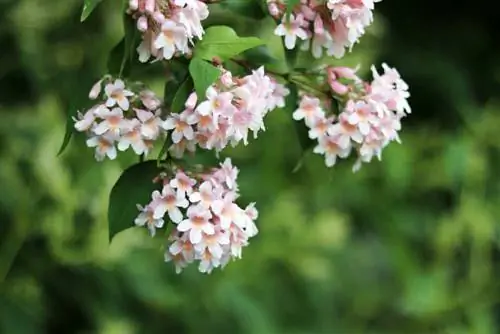
- The perfect time for thinning is also after flowering every two to three years and basically you follow the same pruning procedure.
- When thinning out, however, focus primarily on the oldest shoots that can be found on the Kolkwitzie. These are usually bare and less green than the new shoots. They also hang close to the ground and are therefore easier to spot.
- Now cut back the oldest shoots, which may also be woody, by a full third in length. Depending on its age, you can cut a little more than a third of the plant. Be careful with your eyes.
- Remove shoots that turn inward.
- Cut off shoots that cross each other. Above all, make sure to leave one of the shoots behind so that too much is not cut off and the growth suffers.
- After thinning, follow the same winter preparations to ensure he althy growth of the Kolkwitzia in the new year.
Saving old plants through rejuvenation - step by step
- The rejuvenation cut should be carried out very thoroughly and usually requires sturdy secateurs that can cut thick and woody branches. So have these ready to start the cut.
- With this cut, the bush is shortened significantly and processed all around. Thoroughly cut the individual branches back to the base. Note: none of the branches or shoots should be longer than the other.
- After cutting, the old plant parts must be disposed of thoroughly to avoid infections or infestation by pests and fungi.
- It is crucial when this cut is made. The reason for this is the winter preparation, which is essential for the rejuvenation cut and is carried out in the same way as the other cuts.
What should you pay attention to during the cut?
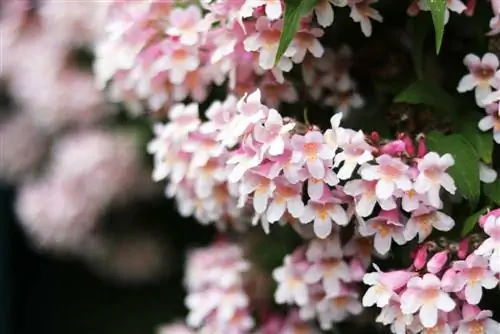
The following points regarding the aesthetic design of Kolkwitzia are important when pruning in order to preserve the natural beauty that is so characteristic of the ornamental shrub:
- Cut slowly and thoroughly
- Observe the shape after each cut
- Correct the shape according to the growth
- Cut evenly along the shape
Since the mother-of-pearl bush has a unique growth habit that ultimately resembles a tunnel, waterfall or veil, you should not dare to make any daring topiary cuts. The Kolkwitzia cannot be trimmed to a specific shape, as the branches hang down over time and develop the characteristic growth. It is therefore important to focus on the shrub and follow its growth. Never cut too closely to the natural shape, otherwise the mother-of-pearl bush may look as if its haircut went wrong.
Be sure to pay attention to the following signs during the cut:
- Leaves curl up
- Leaves turn sickly in summer
- Leaves fall off
- Leaves turn brown in spring
These signs could mean that the shrub has absorbed too much de-icing s alts from the ground that were used to combat snow in the winter. If this is the case, water the shrub thoroughly to clear the soil of the residue. When is the best time for this? Right after you discover the condition. If watering doesn't help, you need to take real action and change the location or refresh the soil.
Brown leaves in spring, on the other hand, are a sign of late frost. Be sure to pay attention to the weather if you want to experience a floral display in summer. Despite their frost resistance, frost damage can occur, especially if you used rejuvenation pruning the previous year.
What happens to the withered flowers of the Kolkwitzia?
Since the ornamental shrub should be cut immediately after flowering, simply remove wilted flowers at the same time as the individual shoots. After cutting, remove the greenery and flowers if they have not completely fallen off the bush itself. A note: the Kolkwitzia basically prepares itself for winter and ideally requires no preparation. But sometimes there are still flowers on the branches that need to be removed for precisely this reason. The shrub is very robust, but old and dead plant parts are a welcome feast for pests and fungi.

